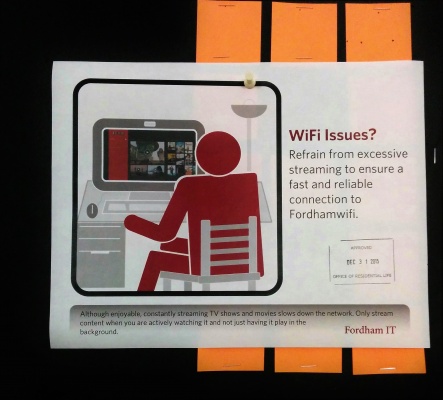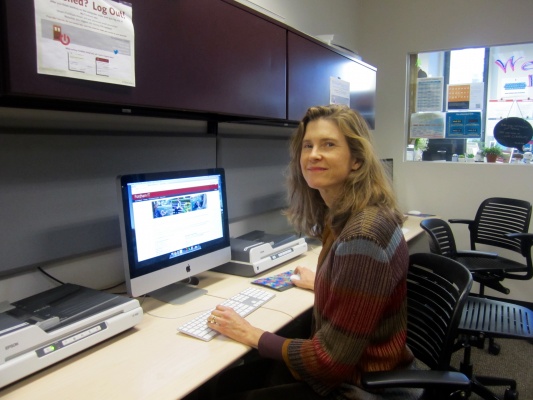Fordham Wi-Fi Issues Persist, Network Upgrade Pending
November 20, 2015
Fordham’s Wi-Fi network continues to cause problems for students. Both the 33 percent increase in device ownership this year and the increasing usage of streaming services have considerably affected the ‘Fordhamwifi’ network.
A few weeks ago, Elizabeth Cornell, director of IT Communications, sent an email to Fordham College at Lincoln Center (FCLC) residents outlining the cause and possible solutions for the poor network performance, while Student Technology Services (STS) has also posted signs throughout the residence halls encouraging students to reduce the usage of streaming services, such as Netflix, by closing them when they are not being used.

The email sent by Cornell on Oct. 23, opened by acknowledging that “we know [students] have had a few problems with [Fordhamwifi] lately.” She promised that “Fordham IT is working on a solution, and you’ll see improvement soon.” Cornell explained that “if streaming and the number of connecting devices are reduced, the network will get faster.”
The email uses an analogy of cars on a highway to demonstrate how less traffic–fewer number of vehicles–can reduce congestion on the network–highway. In this analogy, bandwidth can be thought of as the number of lanes on a highway. The more lanes the highway has, the less traffic there will be, and thus the less congestion.
Furthermore, Netflix could be represented by an endless stream of 18-wheelers, driving on the highway from morning into the night on a daily basis, since the site is highly data-intensive. The more lanes that are taken up by these trucks, the fewer lanes are available for other types of cars, in this case Google searches, research, email, etc., which are far less disruptive.
Taking this one step further, one could consider the speed limit on said highway as equivalent to the speed of the connection, measured in megabits per second (Mbps). The higher the speed limit, the faster the vehicles, or the data, can drive on the highway, or the network.
One additional factor is the connection strength, which can be related to the weather conditions on said highway, or network. If it is a sunny day or there is strong connection, the vehicle will stick to the road and pass through quickly. With more inclement weather or weaker connections, the vehicle will have weaker traction and will not be able to move through as efficiently.
[quote_left]“I can’t see how students are using Netflix from 10:30 a.m. in the morning to almost 1:00 a.m. at night.”[/quote_left]
Mark McNeil, director of Network Services, commented on the “38-40 percent” of the bandwidth that is being utilized by streaming services, stating, “I can’t see how students are using Netflix from 10:30 a.m. in the morning to almost 1:00 a.m. at night.” He did note, however, that instead of throttling, or slowing down, particular applications, such as Netflix, the department will work around this trend by “[giving] it more bandwidth or [changing] the network configuration around, so that access to it is at the requested level.”
When asked how the university determines whether the use of streaming services is suitable for or pertinent to the intended function of the network, neither McNeil nor Cornell would answer during the phone interview, and have not provided a response by email.
McNeil further stated, “if we wanted to increase the bandwidth now, the ability is actually here. We just need to fill out the proper paperwork.” He confirmed that “we are in the process of increasing our bandwidth at both locations,” noting that he should know a week or two after the time of the interview, when the service will be upgraded. The Observer has reached out for further comment, but a response has not been provided at the time of publishing.
The original email from Cornell also explained how “the network is overtaxed by the high number of devices that use it.” Cornell estimated that this number increased by 33 percent in 2015 and will continue to rise. When asked if the school had anticipated this development, McNeil confirmed that the department had indeed been aware.
Despite giving both the Lincoln Center and the Rose Hill environment their own 1 Gbps (1,000 Mbps) connection last year, McNeil remarked that the network problem has persisted. While a 1 Gbps network on its own is technically fast, this speed must be divided amongst all the individual devices on campus, which significantly reduces its performance. Additionally, according to McNeil, the network had roughly “a third more bandwidth to work on” as of last year, but has now reached critical capacity.
McNeil also corroborated the findings from the email, explaining that “this year, [the problem] has been bandwidth utilization of the internet.” As McNeil described, “it’s really hard to say that x amount of bandwidth supports x amount of people,” as this calculation is further complicated by “the sheer number of devices that are associated to one person.”
[quote_right] “It’s really hard to say that x amount of bandwidth supports x amount of people.”[/quote_right]
Any device that uses the Wi-Fi, or even emits a wireless signal (printers, hotspots, etc.), can seriously reduce the wireless strength in a given space. The vast majority of students own at least a laptop (89 percent) and a smartphone (83 percent), and an increasing number own a tablet (45 percent) as well, according to a Pearson study conducted in 2014, which studied 1,228 U.S. college students, “in an effort to determine how they use technology.”
A week prior to Cornell’s email, Fordham Student Technology Services (STS) had also sent out a survey on Oct. 22 on student technology usage and ownership, which asked students, among other things, about their experience using the Wi-Fi network and the number of devices that they own.
When asked about the results of this Fordham-specific survey, Cornell stated in an email response that “we (Fordham IT and STS) use the survey for internal purposes and generally do not publish the data.” However, she did state that she could discuss the results “at the beginning of the spring semester, when we’ve had a chance to absorb the information.”
I have personally experienced these slow speeds and weak connection strength when using the Wi-Fi. Along with another student from the Fordham IT user support department, I decided to test the network strength from within my room and outside in the hall, directly underneath the router (white box hanging from the ceiling) at around 4 p.m. in the afternoon. In my testing, I found that the connection strength became noticeably weaker once inside my dorm, and even more so in my bedroom. At some points during the tests, the wireless strength was half, or even a quarter, it was when directly underneath the router in the hallway. The connection, which according to McNeil changes on a daily basis, was primarily affected by both my distance from the router as well as by interfering signals from other devices on the network.
When the department conducts wireless testing, McNeil explained that “every summer, we [Fordham IT]…walk the entire space (of the rooms), and measure the signal penetration from that particular access point (router boxes in the hallways).” He continued, “we’ll make changes to the access points either by shifting it from its current location, or by adding (access points).” McNeil said that the department has not been able to get to every room to perform testing.
This article will be updated online at fordhamobserver.com when further information is released on the deployment of the upgrades to the network.










